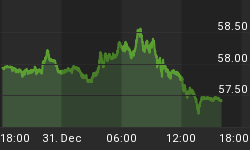I have recently returned from the PDAC convention as an invited speaker. This is the largest mining conference in the entire world. One of the areas which is seeing increased investment interest is the overlooked junior uranium miners (URA) and explorers. The uranium miners have been basing for two years following Fukushima, shaking out plenty of the weak retail investors. However, this undervalued sector may be poised for a major rebound in 2013 as I expect an increase of institutional interest and merger and acquisition activity. Already the two-year downtrend in the uranium prices is being broken to the upside after bouncing off three year lows. (click to enlarge)
For many months, I highlighted the CB&I (CBI) deal with the Shaw Group (SHAW), the Chinese-Cameco connection, The Russians and Uranium One and the coming acquisition of junior explorers in the Athabasca Basin. Witness the acquisition of Fission Energy (FSSIF.PK), which borders the famous Hathor Deposit which was taken over by Rio Tinto (RIO) in 2011. Finally, after two years the sentiment has changed and is turning positive. This sector is extremely active with investment interest and confirms my belief that the death of nuclear that was called by so many analysts over the past two years was premature.
Large companies such as Cameco (CCJ), BHP (BHP) and Rio Tinto are delaying large capital expansions and may be looking for undervalued juniors in mining friendly jurisdictions with easier capital requirements. The uranium sector was active at PDAC as investors expect more deals at these bargain valuations.
The general equity markets are hitting new highs while uranium is well below its pre-credit crisis highs of over $125 a pound. The supply demand imbalance is already present and investors are looking to capitalize on the upcoming expiration of the Russian HEU agreement in 2013. For 20 years an estimated 24 million pounds of uranium were supplied to utilities from Russian warheads. These secondary supplies will now need to be made up by increased uranium mining.
Cameco expects the demand for uranium to increase nearly one third over the next decade. While the rest of the resource sector is weak, the increased M&A in uranium most notably by Uranium One-ARMZ and Fission may be signaling that the big money feels we are near the bottom.
While the precious metals explorers are seeing tight markets, investors are financing uranium exploration companies. Most notably a tiny stock in the Athabasca Basin partnered with Fission. Alpha Minerals (ESOFD.PK) had encouraging drill results and soared seven fold.
Investors are taking interest in good news from uranium explorers, which isn't the case for gold and silver explorers at the moment. Momentum is returning to uranium and investors are beginning to bid up prices. Remember I called this rally many months ago when uranium was completely ignored by 99% of the analyst community.
Finally the mainstream public is realizing that the costs of governments exiting from nuclear energy are just too costly. Following Fukushima a few countries made plans to seek alternatives to nuclear and hopefully rely upon renewables such as wind and solar. This was led most notably by Japan and Germany.
Their are not many high quality producers that are publicly traded after the Uranium One takeout other than Cameco and Paladin (PALAF.PK). Look for producers and near-term producers in the United States who are fully permitted. U.S. utilities need a major increase of uranium mining to power its 104 reactors or else the lights could go out.
Now these same countries may be realizing this may be a failed experiment. A phase out from nuclear would be just too expensive and could prove to be costly to their nation's transmission grids.
Recently, the Japanese people have elected a pro-nuclear government and German utilities are suing the government in opposition to rising electricity costs and air pollution. I would not be surprised to see the German people make a similar move as the Japanese, to swing the other way and turn pro-nuclear to fight rising costs and increased air pollution.
The so called green energy initiative to move away from nuclear has cost Germany dearly not only financially but environmentally. Carbon dioxide emissions increased in 2012 as a result of closing eight nuclear reactors following Fukushima. Germany was on track before Fukushima to reduce noxious emissions to a record low.
The modest exit from nuclear meant more reliance on the use of coal and natural gas. It should be noted, Germany is not nuclear free as many incorrectly assume. Over 16% of Germany's power is still supplied from nuclear.
Industrialized societies increasingly need a form of base-load electricity. Look at the recent Super Bowl when the power went out and the game was stopped. Who would've ever thought that the most popular event in modern day culture could be stalled due to a power failure.
How soon we forget the greatest power outage in history in India just several months ago, which affected 670 million people as the grid collapsed. These power failures are still occurring all over the world. Modern industrial civilizations including the emerging nations such as China, India and Russia need electricity 24 hours a day, 7 days a week, 365 days a year. Consumption is increasing exponentially and will need additional uranium supplies from new low cost mines.
Disclosure: I have no positions in any stocks mentioned, and no plans to initiate any positions within the next 72 hours.

















